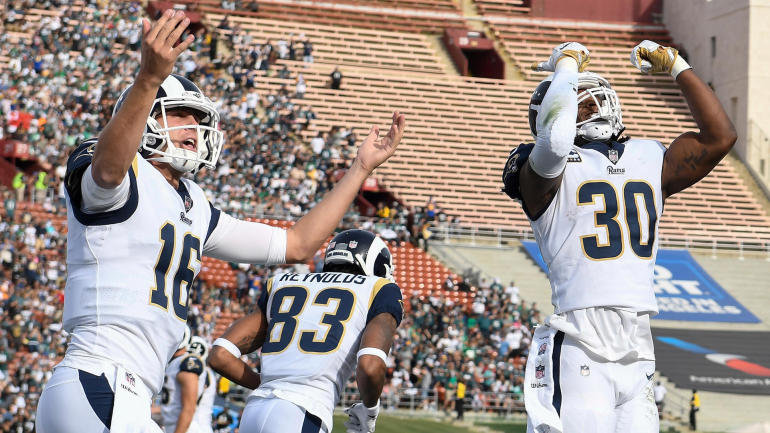Success is cyclical in the NFL and Super Bowl windows are short. Just ask the Seattle Seahawks, who saw what was just a few years ago the best core of players in the NFL dissipate before their very eyes this offseason. Seattle pried open a half-decade-long opportunity to secure titles thanks in large part to smart drafting and aggressive free agency moves, but also largely because it had franchise quarterback Russell Wilson on a cheap rookie contract.
Now the Los Angeles Rams are taking that mantle and running with it, trying to seize their window.
The Rams changed their identity almost wholesale last offseason by replacing Jeff Fisher with Sean McVay, an NFL coaching wunderkind who injected life into the Rams offense. Wade Phillips was his usual defensive revelation self when he arrives in a new landing spot. Everything the Rams did worked, from grabbing multiple Bills wide receivers to signing Andrew Whitworth in free agency.
It all culminated in an incredible 2017 season that saw the Rams upend the NFC West, win the division and host a playoff game. They would lose to the Falcons, but it became obvious they were part of a changing guard in the NFC. L.A. isn’t sitting on its laurels either, spending the offseason at the center of an aggressive trade market, swinging a deal to send Robert Quinn out of town and a pair of deals to bring in cornerbacks Marcus Peters and Aqib Talib.
What’s become obvious is that, following the 2017 season, GM Les Snead and McVay let the smoke clear, looked around and saw a serious window of opportunity for the Rams to take hold of the NFC West and aggressively pursue a Super Bowl run.
For starters, the division flipped overnight.
The Seahawks not-really dynasty is dead, with Seattle trading Michael Bennett, releasing Richard Sherman and expected to move on from Kam Chancellor and Cliff Avril. The Legion of Boom is no more and we don’t know what the Seahawks will look like in 2018. Even if you trust John Schneider and Pete Carroll (and I do), it’s impossible to have the same expectations as years past. The defense is hemorrhaging major talent, and there is no clear-cut answer to the offensive line woes.
The Cardinals don’t have a quarterback on their roster. They’ll find one, and they’ll still be competitive because of Larry Fitzgerald, David Johnson and an underrated defense. But it appears we’re seeing the end of Tyrann Mathieu in Arizona too; the changeover from Bruce Arians to Steve Wilks isn’t guaranteed to be smooth.
The 49ers solved their quarterback problem by trading for Jimmy Garoppolo and everyone is extremely high on San Francisco. It’s understandable, but it might be premature. There’s no guarantee the 49ers are magically a 10-win season next year.
It should be obvious, but the Rams are by far and away the front-runners for this division in 2018 barring something very surprising (Drew Brees to the Cardinals?) happening.
Secondly, they recognized a clear trend for NFL teams to succeed in the modern NFL: the underpaid franchise quarterback.
We just saw it happen with the Eagles and Carson Wentz, even though their star QB suffered a season-ending injury late in the year (coincidentally, against the Rams). Philadelphia drafted Wentz second overall in 2015, which means he’s still on a cheap, four-year rookie contract, with a fifth-year option coming. The Eagles could invest heavily in other areas of their roster because the economic efficiency of Wentz on the roster was so high. He came at a paltry cost relative to the salary cap for his production.
Sound familiar? It should, because the Seahawks won a Super Bowl several years ago that way as well. When Seattle snared Russell Wilson in the third round and inserted him as a productive starter out of the box, they were able to build around him and aggressively invest in other areas of the roster knowing Wilson came at an extremely cheap cost.
The Rams are in the exact same position right now with Goff. Look at this graph from Warren Sharp of Sharp Football Stats, detailing the percentage of cap space each NFL club’s quarterback currently takes up.
All of those teams at the bottom have found their franchise quarterback, in one form or another. Goff might not turn into a Hall of Famer, but he showed in 2017 he is a more than capable starter. He could be great — we just don’t know for sure. He can engineer McVay’s offense at a high enough level to produce big numbers and win football games. At the very least, he looks like an above-average starter in the NFL.
Even though he was the No. 1 overall pick in the draft, Goff is still dirt cheap in terms of salary-cap space.
The Rams, with the cap leaping another $10 million this offseason, are able to be aggressive as a result. They could have held onto Quinn if they needed because of the wiggle room they had. Instead they flipped him for picks.
Tagging LaMarcus Joyner was a no-brainer, and now the addition of Talib and Peters gives Phillips a whole lot of aggressive defensive backs to work with in his defense. Los Angeles is going to be dangerous on both sides of the ball next year, and that’s before we see what they can do in free agency and the draft.
Landing a quarterback, finding the right coach and putting building blocks around them was the first step. But the Rams just got handed a huge opportunity thanks to the rest of the NFC West being forced to churn their rosters and/or identify new personnel to help them succeed.
The window for the Rams to make a run is wide open, and they are taking advantage in a big way already this offseason.
